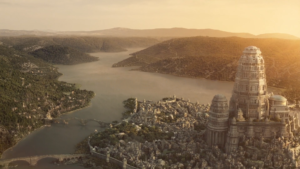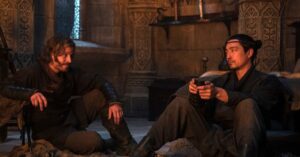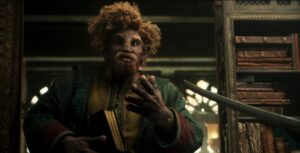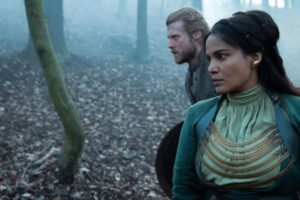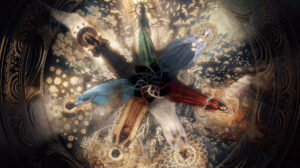SPOILERS FOR THE WHEEL OF TIME BOOK FOUR: THE SHADOW RISING AND BOOK FIVE: FIRES FROM HEAVEN, AND POTENTIAL SPOILERS FOR THE WHEEL OF TIME SEASON THREE AHEAD!
Moiraine Damodred has been prepared to meet a violent end since The Wheel Of Time season one, when she accompanied Rand al’Thor to the Eye of the World expecting to be “ground to dust”, as she put it, between the opposing powers of two cosmic enemies; Rand himself, a.k.a. the Dragon Reborn, and the Dark One. In so doing, she hoped to bring about a quick end to what would otherwise escalate into a large-scale conflict between armies, in which thousands would die and chaos would reign. Given that there are eight seasons of The Wheel Of Time planned, adapting a series of fourteen extraordinarily dense novels, it should go without saying that that is not what happened. Instead, and to her great dismay, Moiraine had to pick herself up after a crushing defeat and keep fighting, for the sake of the world rather than for herself. Throughout season two, which additionally saw her wrestling with the triple-fold loss of her ability to channel, her relationship with her Warder, and the trust of her lover, Moiraine rose again: because the world needed her to.
And now the world needs her to die.

The first teaser trailer for The Wheel Of Time season three follows Moiraine on a trippy journey through “a thousand thousand futures”, stalked and toyed with by the Dark One’s most powerful minions, as it’s revealed to her that across an infinite number of possible realities, one thing remains constant: either she dies, or Rand dies. And Rand is the Dragon Reborn, the only person in the world capable of defeating the Dark One at the Last Battle. He must survive until then, no matter the cost. For Moiraine, therefore, there is no choice to be made. She will die. She doesn’t know when, where, or how – though we see alternate versions of her being strangled and stabbed to death by Lanfear in different scenarios and settings, including one in which Lanfear has seemingly turned Rand and his friends to the dark. She only knows that when the time comes that both their lives hang in the balance, she will see to it that it is she who perishes and Rand who lives to fight another day.
Ironically, the person who probably stands to fare worst out of everyone here is Rand. The best possible outcome for him is the one in which he miraculously makes it to the Last Battle and saves the world before he dies, but death is as much a guarantee for him as it is for Moiraine, and he already knows exactly how his will transpire, as all male channelers inevitably succumb to madness. But even if he makes it that long, and it’s a big “if”, there’s a decent chance he loses to the Dark One and has to watch the world burn because of his failure in his final moments. And if the madness takes him before the Last Battle, it’s not only possible but likely that he’ll end up destroying the world on his own, without the Dark One having to lift a finger. Some of the Aes Sedai sorceresses would happily “gentle” him, permanently removing his ability to channel, but of course, Rand can’t go up against the Dark One without the One Power at his fingertips. And now, on top of everything else he has going on, Moiraine is gonna go and die, burdening him with the pressure that will come from knowing that she did so to save him so that he might save everyone else? I too would run off into the desert if I were Rand.
But for Rand, the solitude of the Waste only offers more grisly ways to die, and I’m not just talking about the harsh weather and living conditions. Rand has deep connections to the Waste and to the people who live there, red-haired warriors known as the Aiel. They have their own set of prophecies about him, distinct from the prophecies of the Dragon Reborn, and to fulfil them, Rand must enter the ruined city of Rhuidean and brave the “glass columns”, a labyrinth of shimmering pillars that allow a person to relive crucial events from the Aiel’s ancient history through the eyes of their own ancestors. The paradigm-altering truths revealed there are too much for some to bear, and they go mad and die inside, which probably explains the veritable forest of spears standing outside the walls of the city in the image above – the spears of all those who entered and did not return. The glass columns of Rhuidean are the setting for one of the most vivid sequences in the entirety of the Wheel Of Time book series, a sequence we can see glimpses of in the images below:


That tree is Avendesora, which grows at the center of the glass columns and is sacred to the Aiel, who gifted a sapling from Avendesora to the people of Cairhien to repay an old debt. The tree that sprang from that sapling, Avendoraldera, was later cut down by Moiraine’s uncle, King Laman Damodred, and its precious wood used to build him a larger throne, resulting in the Aiel War during which a coalition of the Aiel clans left the Waste, sacked Cairhien, killed Laman, and left, but not before one Aiel Maiden of the Spear gave birth to a son, Rand himself, on the blood-soaked slopes of Dragonmount. I know, I know, I just threw a lot of lore at you, but you’re here for a trailer breakdown, aren’t you? Let’s not even get into the fact that Avendesora isn’t technically a tree but a unique organism genetically engineered with the One Power…
While Rand peruses AielAncestry.com, Egwene begins learning from the Aiel Wise Ones how to “Dreamwalk” – enter the World of Dreams at will. The World of Dreams, or Tel’aran’rhiod, is the nebulous realm humans unconsciously enter when they sleep. The Wise Ones have mastered the ability to navigate this realm and manipulate it to a degree, though not to the level of someone like Lanfear, who considers herself the Queen of Tel’aran’rhiod, or Moghedien, whose power there is even greater. But Egwene in season three has just endured weeks or possibly months of imprisonment at the hands of the Seanchan and the appropriation of her own powers by a sadistic captor whom she brutally murdered. She is a very different woman than she was before that experience, and if Lanfear or Moghedien think they can toy with her in the World of Dreams, they’ve got another think coming. Let me remind you all that Egwene was able to single-handedly hold off Ishamael, the strongest of the Forsaken, for several minutes while beaten up and bruised in the immediate aftermath of the aforementioned murder.


We see Egwene and Rand lying next to each other in a tent, hands not quite touching, possibly indicating that they’ll Dreamwalk together, or perhaps belonging to a scene in which the two finally agree to end the untenable romantic relationship that was already on the rocks back in season one, even before Rand faked his death and ran away in an effort to protect her from himself. There are not many “Randgwene” shippers out there, but I am one, and I know that Wheel Of Time showrunner Rafe Judkins is another because the doomed love between Rand and Egwene has been a focal point of both season finales and a major factor in important decisions both characters have made, even though they technically called it quits in the very first episode, and Rand was briefly in a sexual relationship with Lanfear (a relationship that Lanfear is intent on rekindling, based on the trailer). But now, with Rand and Egwene starting down diverging paths, there has to be some kind of closure there before either character begins actively pursuing their eventual love interests.


Love is in the cards for at least one of our main characters, though, as Perrin Aybara is shown kissing a dark-haired woman whom we can safely assume is Faile, the Hunter for the Horn who follows Perrin back to the Two Rivers in book four, The Shadow Rising, when he goes home to help liberate his people from an army of Whitecloaks under the command of his archnemesis Dain Bornhald. Perrin and Faile have a…tumultuous relationship in the books; I’ll be curious to see how The Wheel Of Time adapts that, especially with the significant change they’ve made to Perrin’s backstory, giving him a wife whose death he is directly responsible for, and whose memory still haunts him. Speaking of closure, Perrin’s return to the “scene of the crime” in season three will provide him a much-needed opportunity to put Laila to rest amidst everything else going on in the Two Rivers. There’s no sign in the trailer of Dain Bornhald himself, the peddler Padan Fain, or the mysterious Lord Luc, all key players in Perrin’s The Shadow Rising arc, but we do see Perrin leading the defense of the Two Rivers, so they’re around somewhere.

Also conspicuously absent is the character of Elaida, one of The Wheel Of Time‘s most important antagonists, expected to be played by Oscar-nominated actress Shohreh Aghdashloo, who joined the cast after playfully engaging with fans and showrunner Rafe Judkins on social media who were fan-casting her as a different character, Cadsuane Melaidhrin. I thought we might have seen her briefly (see the image above), because what other Aes Sedai from the Red Ajah would be so brazenly enthroned on the Amyrlin Seat with a dark-haired woman in white at her side, but I’ve since been informed that the women in the image are more likely Liandrin Guirale and Lanfear, during some kind of dream sequence. You have to zoom in really close, but the woman on the throne does appear to have blonde hair and Kate Fleetwood’s distinctive cheekbones.

Liandrin is also shown unveiling herself at some kind of costume party (probably at the Panarch’s Palace in Tanchico, where she hides out in The Shadow Rising), speaking to the Forsaken Moghedien, and dueling Alanna Mosvani of the Green Ajah (potentially killing one or both of her Warders, based on a shot of Alanna sobbing over someone’s body) in the streets of Tar Valon itself, where violence is practically unheard of, let alone violence between Aes Sedai. But of course, Liandrin is no ordinary Aes Sedai: she may be Red Ajah, but her true loyalties lie with the Black Ajah, a faction of sorceresses sworn to the Dark One, whose existence was a closely-guarded secret. In the books, Siuan Sanche is able to cover up Liandrin’s betrayal because it happens within the White Tower, behind closed doors, but if the show has her and Alanna blowing up large swathes of the city, that obviously won’t be possible, and there could be ripple effects: maybe the people of Tar Valon will begin to feel unsafe in the shadow of the Tower, and Elaida’s attempts to undermine Siuan’s authority will center around fanning the flames of this growing dissent.

Something that I personally find very relieving is the fact that we see Siuan at the White Tower, specifically during what looks to be Egwene’s Accepted Test. You may remember that when season two was airing, I was…very vocal about my displeasure with how The Wheel Of Time was characterizing Siuan. I don’t feel like rehashing it all right now (you can read what I wrote then here) but one of my points was that Siuan being offscreen for most of the season and her long absence being hand-waved away, especially while Novices were being kidnapped from the White Tower, was not going to help endear her to audiences who still barely know her as a character in her own right, separate from Moiraine, with whom she shares nearly every scene in which she’s appeared and who is usually the viewpoint character in these scenes. It would be one thing if season three wasn’t adapting the events of The Shadow Rising, but if you’ve read that book, you probably know what I’m referring to when I say it’s about to be really important that audiences know Siuan and care about Siuan (again: separately from Moiraine!), and that’s a lot more difficult when she’s hardly ever around! And when she DOES show up, it’s to try and imprison Rand and abuse the Oath Moiraine swore to her…sorry, sorry, I said I wouldn’t rehash my issues with that episode. Let’s just say, I’m very happy to see her.

I’d have loved to have seen a little bit more than one frame each of Nynaeve al’Meara, Mat Cauthon, Aviendha, and Min Farshaw. Nynaeve, because Zoë Robins has top-billing after Rosamund Pike and Daniel Henney, and it’s a little weird to not see that reflected at all in the marketing, but also because Nynaeve had by far the least to do out of the Emond’s Field Five in the season two finale (I wholeheartedly believe that the plan up until the last minute was for her to rescue Egwene from the Seanchan kennels as she does in the books, and when the writers decided they were gonna have Egwene break herself out of captivity, they had no idea what to do with Nynaeve, and pulling an arrow out of Elayne’s leg for twenty minutes was the best they could come up with on a tight schedule and budget). I really need season three to remind people that she is not helpless without the One Power.
And Mat, well, I just want the poor guy to have some screentime this season. Though it’d sure be nice if he could have his long-awaited quarterstaff fight with Gawyn and Galad (who I suppose I should mention does appear in the trailer; there, I mentioned him). To be fair, Mat did get temporarily written off the show after the original actor abruptly dropped out midway through filming season one, requiring a recast and major rewrites, so he had to play catch-up throughout season two, but now that his storyline is pretty much back on track, I’m hopeful that season three will do more with him and with actor Dónal Finn.
A few stray observations: the cinematography has massively improved, and the budget looks much bigger, though I don’t have the exact numbers to state that with certainty. The VFX for the channeling is more seamless, the weaves more complex and more colorful, the digitally rendered environments and armies more expansive. I notice a lot of costumes from season two making a reappearance, but equally as many gorgeous new designs, with Alanna Mosvani’s gold-spangled green dress, the alternate reality Emond’s Field Five fits, and the head-to-toe white lace garments of the Wise Ones being particular favorites of mine already. And while I would never think to juxtapose the subject matter of The Wheel Of Time with “Hazy Shade of Winter” by The Bangles, I’ve gotta admit…it does work weirdly well. I mean, doesn’t hurt that it opens with the refrain “time, time, time”.
But now I want to hear what you think? What was your favorite part of the trailer? Share your own thoughts, theories, and opinions, in the comments below!
The Wheel Of Time returns for its third season on March 13th, 2025



